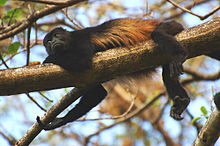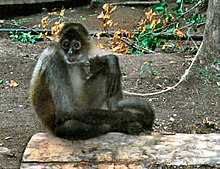List of Costa Rican monkey species


Four species of monkey are native to the forests of
The smallest of the Costa Rican monkey species is the Central American squirrel monkey. Adult males average 0.8 kg (1.8 lb) and adult females average 0.7 kg (1.5 lb).
The other three species have wider ranges within Costa Rica, each being found in forests over much of the country.
It is unknown why the Central American squirrel monkey has such a restricted range relative to the other Costa Rican monkey species. One theory is that the Central American squirrel monkey's ancestors arrived in Central America earlier than the ancestors of the other species. Under this theory, the squirrel monkey's ancestors arrived in Central America between 3 and 3.5 million years ago, but could not compete effectively when the ancestors of the other species arrived in Central America about 2 million years ago. The other species thus drove the squirrel monkey out of most of its original range. Another factor may be the Central American squirrel monkey's preference for lowland, coastal areas, which may make them more vulnerable to significant population declines due to occasional major hurricanes.[20]
Two other monkey species are sometimes reported as living in Costa Rica, Geoffroy's tamarin (Saguinus geoffroyi) and the Panamanian night monkey (Aotus zonalis or Aotus lemurinus zonalis).[1][21][22] The western edge of Geoffroy's tamarin's known range is just west of the Panama Canal zone, about 200 kilometres (120 mi) from the Costa Rica border, and thus reports of it living in Costa Rica are most likely erroneous.[1][21] Confusion may have resulted from the fact that over part of its range Geoffroy's tamarin is locally referred to as mono titi, which is a name also used for the Central American squirrel monkey in Costa Rica.[1] Reports of the Panamanian night monkey living in Costa Rica are plausible, since the species is known to occur on the Caribbean coast of Panama not far from the Costa Rica border.[1][22] However, reports of it living in Costa Rica have not been confirmed by scientists.[1][22]
Key

| Common Name | Common name of the species, per Wilson, et al. Mammal Species of the World (2005) |
| Scientific Name | Scientific name of the species |
| Family | Family within New World monkeys to which the species belongs |
| Average Size – Male | Average size of adult male members of the species, in kilograms and pounds, per Campbell, et al. Primates in Perspective (2007) |
| Average Size – Female | Average size of adult female members of the species, in kilograms and pounds, per Campbell, et al. Primates in Perspective (2007) |
| Conservation Status | Conservation status of the species, per IUCN as of 2008
|
| Range | Countries in which the species occurs; |
Costa Rican monkey species

| Common Name | Scientific Name | Family | Average Size – Male | Average Size – Female | Conservation Status | Range | References |
|---|---|---|---|---|---|---|---|
| Central American squirrel monkey | Saimiri oerstedii
|
Cebidae | 0.829 kg (1.83 lb) | 0.695 kg (1.53 lb) | Endangered | Costa Rica, Panama | [9][11][23] |
| Panamanian white-faced capuchin | Cebus imitator
|
Cebidae | 3.668 kg (8.09 lb) | 2.666 kg (5.88 lb) | Vulnerable | Honduras through Ecuador | [2][9][14][24] |
| Mantled howler | Alouatta palliata
|
Atelidae | 7.150 kg (15.76 lb) | 5.350 kg (11.79 lb) | Vulnerable | Mexico through Ecuador | [15][16][25] |
| Geoffroy's spider monkey | Ateles geoffroyi
|
Atelidae | 8.210 kg (18.10 lb) | 7.700 kg (16.98 lb) | Endangered | Mexico through Panama | [16][17][26] |
References
- ^ ISBN 0-9705678-1-2.
- ^ ISBN 978-8496553897.)
{{cite book}}: CS1 maint: multiple names: authors list (link - ISBN 978-0-19-517133-4.
- OCLC 62265494.
- OCLC 62265494.
- ISBN 0-471-94440-8.
- ISBN 1-74104-463-4.
- ISBN 1-86450-034-4.
- ^ ISBN 978-0-19-517133-4.
- ISBN 0-226-20721-8.
- ^ . Retrieved 27 December 2017.
- ISBN 1-86450-034-4.
- ^ ISBN 0-19-506401-1.
- ^ . Retrieved 11 November 2021.
- ^ . Retrieved 27 December 2017.
- ^ ISBN 978-0-19-517133-4.
- ^ . Retrieved 27 December 2017.
- ISBN 1-86450-034-4.
- ISBN 1-86450-034-4.
- ISBN 0-387-25854-X.
- ^ ISBN 0-387-25854-X.
- ^ ISBN 0-387-25854-X.
- OCLC 62265494.
- OCLC 62265494.
- OCLC 62265494.
- OCLC 62265494.
